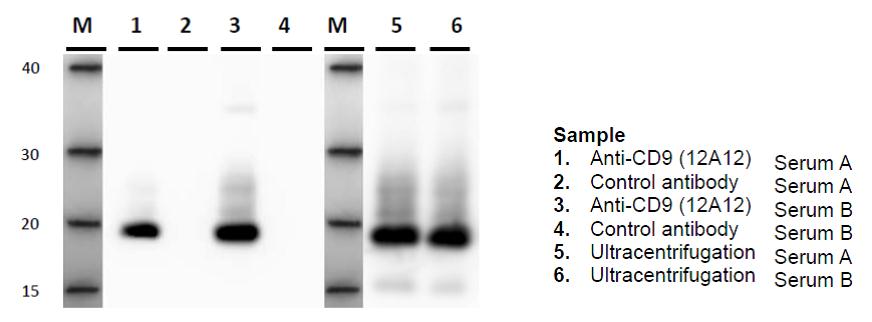Exosomes
Exosomes are cell-derived vesicles that are formed by a lipid bilayer membrane. Their diameter is around 40-100 nm. They are observed in body fluids such as saliva, blood, urine, amniotic fluid or malignant ascites and secreted from cultivated cells. Recently, exosomes have been shown to include various proteins and RNAs that may be able to function in intercellular signal transduction. CD9, CD63 and CD81 are known as exosome markers. CD9 is a cell surface glycoprotein that belongs to the tetraspanin superfamily. It is known to complex with integrins and other transmembrane 4 superfamily proteins. The glycoprotein is found on the surface of the exosomes. It can be cell adhesion, migration, modulate aggregation and also trigger platelet activation. CD63 (also known as LAMP-3, melanoma-associated antigen ME491, TSPAN30, MLA1 and OMA81H) is a cell surface glycoprotein that belongs to the tetraspanin superfamily. LAMP-3 complexes with integrins. It is mainly expressed on activated platelets, monocytes, macrophages and weakly on granulocytes, T cells and B cells. CD81 (TAPA-1) is a cell surface protein that also belongs to the tetraspanin superfamily. TAPA-1 is identified as a component of the B lymphocyte receptor (BCR) and as a receptor for the hepatitis C virus. It is mainly expressed on activated platelets, monocytes, macrophages and weakly on granulocytes, T cells and B cells. CD81 (TAPA-1) is a cell surface protein that also belongs to the tetraspanin superfamily. TAPA-1 is identified as a component of the B lymphocyte receptor (BCR) and as a receptor for the hepatitis C virus. It is mainly expressed on activated platelets, monocytes, macrophages and weakly on granulocytes, T cells and B cells. CD81 (TAPA-1) is a cell surface protein that also belongs to the tetraspanin superfamily. TAPA-1 is identified as a component of the B lymphocyte receptor (BCR) and as a receptor for the hepatitis C virus.
Properties and advantages
– high specificity for the exosomal membrane proteins CD9, CD63, CD81
– Up to 100% of the exosomes can be isolated in a 150 µl sample using only 1 µg of the antibody
Supported samples:
CD9: serum
CD63: serum, culture supernatant
CD81: serum, culture supernatant
– Useful for the analysis of exosome surface antigen proteins, endogenous RNA (miRNA) and proteins
Examples of use
1) IP-WB exosome in serum sample with anti-CD9 antibody (12A12)

2) IP-WB exosome in serum sample with anti-CD63 antibody (8A12)

3) IP-WB exosome in serum sample with anti-CD81 antibody (12C4)

Products
The antibodies that can specifically detect CD9, CD63 and CD81 are listed below. These antibodies are suitable for the isolation of exosomes by immunoprecipitation.
| product name | Catalog no. | Quantity |
| Anti CD9 | CAC-SHI-EXO-M01-50 | 50 µL |
| Anti CD9 | CAC-SHI-EXO-M01 | 100 µL |
| Anti CD63 | CAC-SHI-EXO-M02-50 | 50 µL |
| Anti CD63 | CAC-SHI-EXO-M02 | 100 µL |
| Anti CD81 | CAC-SHI-EXO-M03-50 | 50 µL |
| Anti CD81 | CAC-SHI-EXO-M03 | 100 µl |


